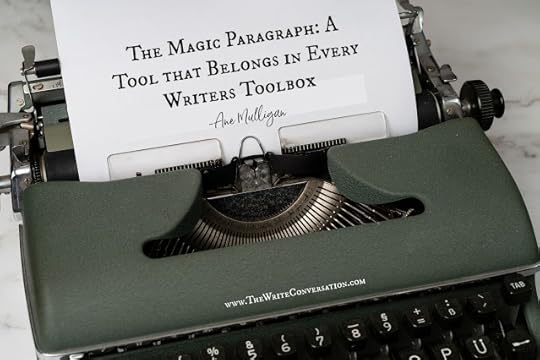The Magic Paragraph: A Tool that Belongs in Every Writers Toolbox

by Ane Mulligan @AneMulligan
Developed by the late Ron Benrey, the Magic Paragraph has served authors well for many years. I learned about it at the Blue Ridge Mountains Christian Writers Conference in 2003. I still rely on it. It's one of those Golden Nuggets that belongs in every writer's toolbox. When Ron passed away, his wife, Janet Benrey, gave me permission to carry on its teaching.
What is the Magic Paragraph?
This little tool, the Magic Paragraph, isn’t a formula per se. It’s a guide to showing what’s in your character’s head. It keeps the reader grounded in whose Point of View (POV). It helps ground you the author in deeper POV by step two.
So without further ado, here is The Magic Paragraph.Signal whose head to enterWrite an appropriate sense, emotion or mental facultyShow appropriate action or responseRepeat if necessary Breaking that down, the first one is fairly self-explanatory. Begin by letting the reader know whose POV.
Jane plopped her backside down on the curb.
We know we’re in Jane’s head. You don’t have to start with the name, but give it fairly soon, so the reader knows who it is. In one of my books, I started it this way:
The morning fog was about as thick as the pea soup Great-aunt Lola used to make. Claire hated that soup then and she didn’t much like this fog now.
I give you the POV character's name in the second sentence. And you wouldn’t confuse the POV character with Great-aunt Lola, because she wouldn’t think of herself or her soup in that way.
In those same two opening sentences, I have both the first and second bullets in the magic paragraph.
I signaled whose head to enter and then I recorded an appropriate sense, emotion or mental faculty for the character.
Here’s another one to follow Jane’s opening line.
Jane plopped her backside down on the curb. Her spirit was so low she could probably dangle her feet and not touch the water trickling in the gutter.
Next is to show an appropriate action.
For Claire it’s:
The morning fog was about as thick as the pea soup Great-aunt Lola used to make. Claire hated that soup then and she didn’t much like this fog now. She swished her hand back and forth in an impotent attempt to dispel it.
For Jane:
Jane plopped her backside down on the curb. Her spirit was so low she could probably dangle her feet and not touch the water trickling in the gutter. She pulled a crumpled tissue from her pocket and blew her nose, wishing she could blow away her problems as easily.
The last item is Repeat if necessary. At the very least, at the beginning of each scene. You need to keep the reader grounded in your POV character’s head. Take your reader on the journey, making them privy to your POV character’s innermost thoughts.
So there you have it, The Magic Paragraph. Use it to help keep your story and your reader grounded in your character’s POV.
Not long before he passed away, Ron wrote The Idiot's Guide To Writing Christian Fiction . The Magic Paragraph is part of the book, too.
TWEETABLEThe Magic Paragraph: A Tool that Belongs in Every Writers Toolbox from @AneMulligan on @EdieMelson (Click to Tweet)
 Ane Mulligan lives life from a director’s chair, both in theatre and at her desk, creating novels. Entranced with story by age three, at five, she saw PETER PAN onstage and was struck with a fever from which she never recovered—stage fever. One day, her passions collided, and an award-winning, bestselling novelist immerged. She believes chocolate and coffee are two of the four major food groups and lives in Sugar Hill, GA, with her artist husband and a rascally Rottweiler. Find Ane on her website, Amazon Author page, Facebook, Instagram, Pinterest, The Write Conversation,and Blue Ridge Conference Blog.
Ane Mulligan lives life from a director’s chair, both in theatre and at her desk, creating novels. Entranced with story by age three, at five, she saw PETER PAN onstage and was struck with a fever from which she never recovered—stage fever. One day, her passions collided, and an award-winning, bestselling novelist immerged. She believes chocolate and coffee are two of the four major food groups and lives in Sugar Hill, GA, with her artist husband and a rascally Rottweiler. Find Ane on her website, Amazon Author page, Facebook, Instagram, Pinterest, The Write Conversation,and Blue Ridge Conference Blog.
Published on July 24, 2022 22:00
No comments have been added yet.



